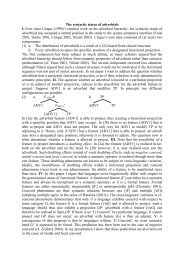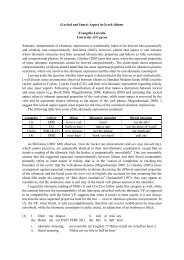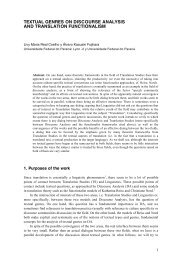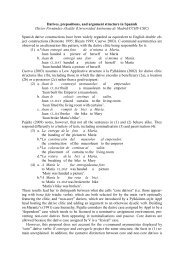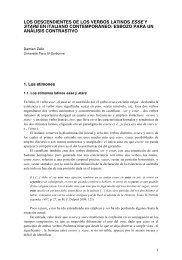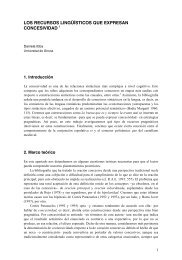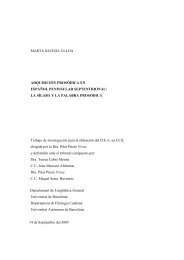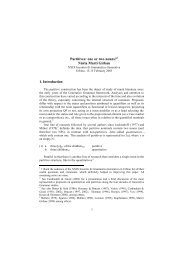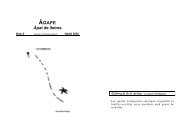Prefixation in English and Catalan - Departament de Filologia ...
Prefixation in English and Catalan - Departament de Filologia ...
Prefixation in English and Catalan - Departament de Filologia ...
You also want an ePaper? Increase the reach of your titles
YUMPU automatically turns print PDFs into web optimized ePapers that Google loves.
[-m] (unspecified for /c) usually express<strong>in</strong>g subject matter/locative source<br />
[-c] (unspecified for /m) usually express<strong>in</strong>g <strong>in</strong>ternal roles like goal,<br />
benefactor (typically dative or PP)<br />
Any l<strong>in</strong>k<strong>in</strong>g theory about Θ-roles has to map the thematic specification (irrespective of<br />
its representation by means of Θ-role labels, feature clusters, etc.) of a lexical entry onto<br />
syntactic positions. That is, there must be rules or some mapp<strong>in</strong>g connect<strong>in</strong>g the notion<br />
agent or the cluster [+c+m] to notions like external <strong>and</strong> to a specific position <strong>in</strong> the<br />
sentence. (See Williams (1981b), Carrier-Duncan (1985), Baker (1988), Grimshaw<br />
(1990), Neeleman & Schipper (1992), Samek-Lodovici (2003), for some l<strong>in</strong>k<strong>in</strong>g<br />
suggestions). 5 Re<strong>in</strong>hart (2001) proposes that there is a lexical operation which assigns<br />
<strong>in</strong>dices to the roles on the V’s Θ-grid: 1 marks the external role <strong>and</strong> 2 marks the <strong>in</strong>ternal<br />
role. These mark<strong>in</strong>g procedures only apply to verbal entries with at least two arguments,<br />
by assign<strong>in</strong>g <strong>in</strong><strong>de</strong>x 2 to a [-] cluster ([-c-m], [-c], [-m]) <strong>and</strong> <strong>in</strong><strong>de</strong>x 1 to a [+] cluster<br />
([+c+m], [+c], [+m]). The result is that a cluster marked 2 must merge <strong>in</strong>ternally <strong>and</strong> a<br />
cluster marked 1 must merge externally. 6 Only mixed clusters ([+c-m], [-c+m]), which<br />
are not marked, can merge <strong>in</strong> either position, subject to other requirements (e.g. Merge<br />
externally whenever possible for economy reasons, s<strong>in</strong>ce the external position must<br />
always be filled eventually).<br />
Given Re<strong>in</strong>hart’s assumption that each V is associated with only one thematic<br />
structure <strong>and</strong> that all Vs are un<strong>de</strong>rly<strong>in</strong>gly transitive, 7 she <strong>de</strong>rives reflexives,<br />
unaccusatives <strong>and</strong> unergatives by means of a lexical operation called reduction, which<br />
reduces the V’s arity by one. If the <strong>in</strong>ternal argument is reduced (i.e. if the operation<br />
Re<strong>in</strong>hart calls reflexivization applies), a reflexive entry is <strong>de</strong>rived. If the external<br />
argument (necessarily specified as [+c]) is reduced (i.e. expletivization has applied, <strong>in</strong><br />
Re<strong>in</strong>hart’s terms), the result can either be an unaccusative or an unergative alternate, a<br />
result which will <strong>de</strong>pend on the feature specification of the rema<strong>in</strong><strong>in</strong>g argument. To see<br />
5 For example, Williams (1981a) dist<strong>in</strong>guishes the external Θ-role by un<strong>de</strong>rl<strong>in</strong><strong>in</strong>g it or <strong>in</strong> Grimshaw’s<br />
(1990) thematic hierarchy, the external Θ-role corresponds to the least embed<strong>de</strong>d one. These are just<br />
some of the conventions to relate roles to syntactic positions. That is, the un<strong>de</strong>rl<strong>in</strong>ed Θ-role <strong>in</strong> Williams or<br />
the least embed<strong>de</strong>d Θ-role <strong>in</strong> Grimshaw’s system is merged externally.<br />
6 External merg<strong>in</strong>g refers to that role merged outsi<strong>de</strong> the maximal projection of its predicate, <strong>and</strong> <strong>in</strong>ternal<br />
merg<strong>in</strong>g refers to those roles merged with<strong>in</strong> the maximal projection of their predicate.<br />
7 The relationship between the causative <strong>and</strong> <strong>in</strong>choative forms of a V is still an open issue <strong>in</strong> generative<br />
grammar. It is generally assumed that one form <strong>de</strong>rives from the other <strong>in</strong> the lexicon, but it is not clear<br />
which form is the basic one. For example, Re<strong>in</strong>hart (2000, 2001) believes that the <strong>in</strong>choative form <strong>de</strong>rives<br />
from the causative, whereas HK (1998) claims the opposite. See Gràcia (1995) for a different view,<br />
accord<strong>in</strong>g to which the two forms share the same base, but neither of them is <strong>de</strong>rived from the other.<br />
7



